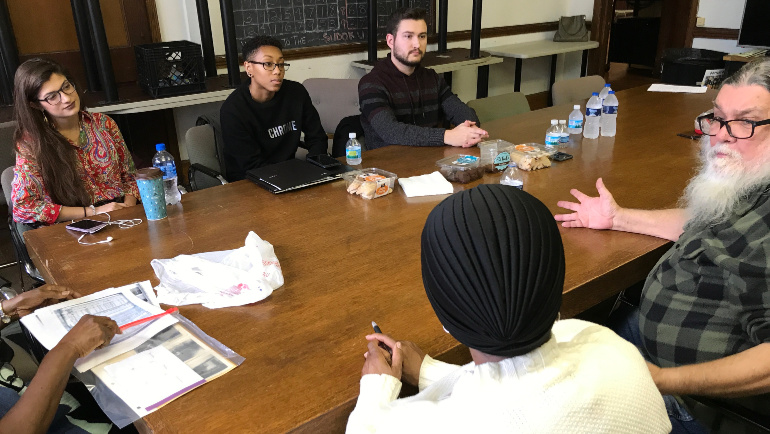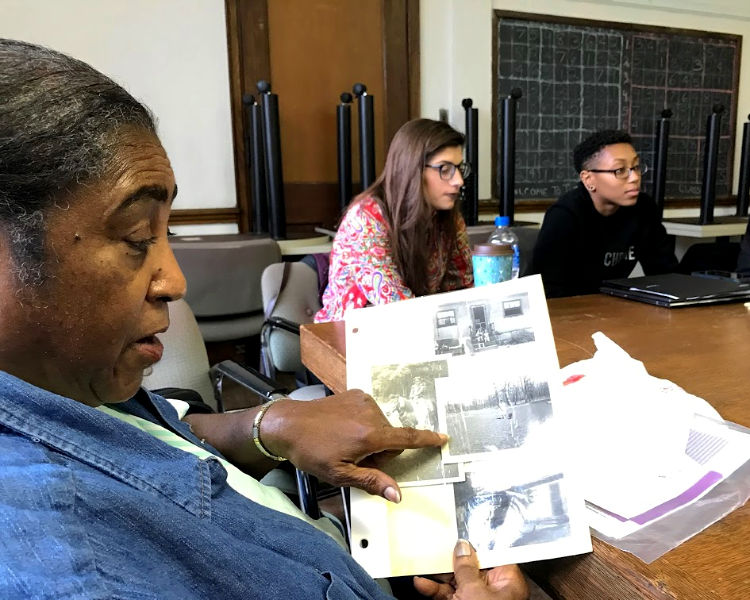
Mix Wayne State undergraduate students with neighboring older adults for a few hours each week and what do you get? Friends.
“I didn’t think I would create this bond with seniors,” said Tia Talton, a sophomore studying kinesiology. “It’s been three or four years since I’ve had much contact with older adults.”
The students visited Detroit’s St. Patrick’s Senior Center as part of their Developmental Psychology Service Learning Laboratory class. Taught by Professor Hilary Ratner, director of training at the Merrill Palmer Skillman Institute, the class is a project-based addendum to developmental psychology that looks at changes throughout the lifespan. Students choose from a variety of service learning sites serving youth, adults or older adults.
Talton chose St. Pat’s because, “I wanted to learn about older adults, share their wisdom. It was an even better experience than I thought it would be.” The students write weekly reflections and observations of their experiences in the field, connect a journal article about developmental psychology with their service learning, and write a final summary paper.

“It really makes my day to hear what the students had to say about their experiences in the community,” Ratner said. “It's clear that their conversations at St. Pat's were meaningful to them and will be important in their lives.”
Dylan Johnson, a senior at Wayne State studying political science, enjoyed learning history from people who have been there. “My history classes taught about racism from a book. The seniors here talk about trauma and racism from their life. One woman couldn’t attend the elementary school next to her house because it was for white kids only. It makes it real,” he said.
The original mission of the students at St. Pat’s was to help older adults write their life stories. After two visits, though, “we kept straying from writing individual stories,” said psychology sophomore Isabella Leone.
“It was more topic driven, with everyone wanting to contribute,” she said. “We had lots of open-ended discussion of the life story questions and not so much writing.” Topics included memories of war, sexism, racism, working in coal mines and disciplining children.
“We’re better than visiting a museum,” said Gerald “Jerry” Dajnowicz, a regular visitor at St. Pat’s. “The young people were in historic shock. They can’t believe we used pay phones. That we talked on party lines we shared with other people. We also got into serious things, like Vietnam — I was there — and living in housing projects. Our discussions are lively.”
Leone chose St. Pat’s because she worked with young children before and wanted something different. When the St. Pat’s team met before their first visit, they shared fears of how it would go.
“We thought the older adults would be intimidating, maybe even mean. We didn’t know what to expect,” Leone said. “But no one here is mean. They’re funny, passionate. Lots of energy, fire and honesty.”
The experience was so positive that most of the team planned to continue volunteering at St. Pat’s after the class ended. “It opened my eyes to getting older,” Leone said. “How similar we are and how different. They were so inspiring.”
This story originally appeared in the spring 2019 edition of Transitions.
